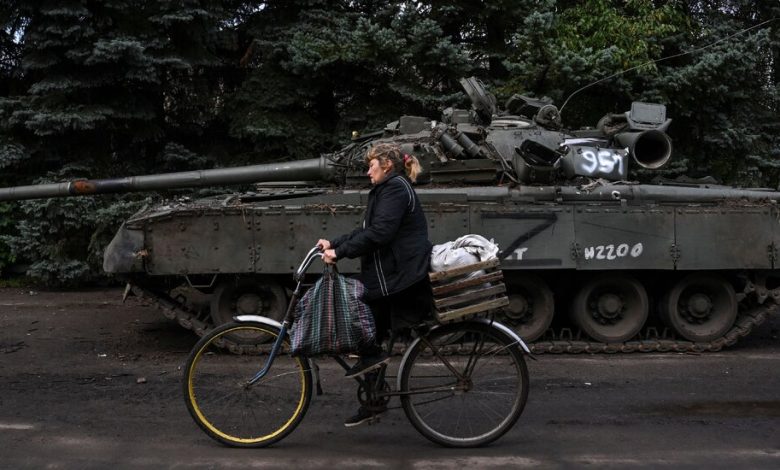What to Know About Russia’s Annexation of Four Ukrainian Provinces

President Vladimir V. Putin plans to declare on Friday that some 40,000 square miles of eastern and southern Ukraine will become part of Russia — an annexation broadly denounced by the West, but a signal that the Russian leader is prepared to raise the stakes in the seven-month-old war.
Mr. Putin is expected to deliver a “voluminous” speech, his spokesman said. He is likely to downplay his military’s struggles in Ukraine and rising domestic dissent. He will probably ignore worldwide denunciations of discredited referendums held in occupied Ukraine on joining Russia, where some were made to vote at gunpoint.
Here is what we know:
What is Russia proposing?
Russia is proposing to annex four provinces — Luhansk, Donetsk, Zaporizka and Kherson — in the south and the east of Ukraine where intense fighting continues. Moscow hastily put the plan in motion after a humiliating battlefield defeat drove the Russian Army out of another province, Kharkiv, in early September and the Ukrainian advance appeared to be gathering force.
The State of the War
- Annexation Push: After sham referendums in four Russian-occupied territories in Ukraine, where some were made to vote at gunpoint, the Kremlin is moving ahead with plans to annex the regions.
- Nord Stream Pipeline: Explosions under the Baltic Sea and the rupture of major natural gas pipelines from Russia to Germany appeared to be a deliberate attack, European officials said, exposing the vulnerability of the continent’s energy infrastructure. But a mystery remains: Who did it?
- The Eastern Front: The battle for the critical Donbas region in Ukraine’s east is now centered on two strategically important cities: Lyman and Bakhmut. The fighting is fierce as both Russian and Ukrainian forces race to claim new ground before winter sets in.
- Russia’s Draft: The Kremlin has acknowledged that its new military draft has been rife with problems — an admission that comes after protests have erupted across Russia, recruitment centers have been attacked and thousands of men leave the country.
The Kremlin plans to declare the land where battles are raging in all four regions to be Russian territory and to assert that it is defending, not attacking, in the war in Ukraine — and so it is justified to use any military means necessary, a thinly veiled nuclear threat. Annexing the provinces would be used as a rationale for drafting Ukrainian men living there to fight other Ukrainians in the war, helping to solve a shortage of troops in the Russian Army.
Why does the international community oppose it?
The United States, its European allies and many other countries oppose Russia’s nuclear saber rattling and say that allowing a country to capture new territory militarily sets a destabilizing precedent. After Russia’s invasion of Ukraine in February, an article published by the Council on Foreign Relations observed that Russia, a member of the United Nations, was violating the United Nations Charter, which requires that U.N. member states refrain from the “use of force against the territorial integrity or political independence of any state.”
Western allies of Ukraine say the supposed referendums showing support for uniting with Russia were a sham, as some residents of occupied areas were forced to vote at gunpoint, and a large portion of the population had fled as internally displaced people or refugees. The final tallies could also have easily been falsified.
How much land in the regions do the Russians control?
Much of the territory Russia is poised to claim as its territory is occupied by the Russian army already. Russia captured and set up client states controlling about a third of two provinces, Donetsk and Luhansk, in a war that began in 2014. Its military advanced into the other two provinces, Zaporizka and Kherson, in the invasion that began in February.
The front lines have shifted in fierce, seesaw fighting over the seven months of the war, with Russia mostly losing ground. The Russian army now controls most of the Luhansk and Kherson regions and about half of the Zaporizka and Donetsk regions. Thousands of square miles of territory and hundreds of cities, towns and villages Russia is poised to claim as its own are now under firm Ukrainian control in the Donetsk and Zaporizka regions, including the capital of one province, the city of Zaporizhzhia.
How is Ukraine responding?
President Volodymyr Zelensky of Ukraine and his ministers and commanders say they will continue their fight to expel the Russian Army from Ukraine, regardless of whether Moscow calls parts of their country Russia.
What is the process, and what comes next?
The Kremlin is using pageantry and a show of adhering to Russian legal formalities to give the annexation a veneer of legitimacy. A rally is planned on Red Square on Friday to celebrate. The proxy leaders of the four provinces have traveled to Moscow and appealed to Mr. Putin to accept their regions as part of Russia. If the process follows a template laid down in 2014 when Russia annexed another Ukrainian region, Crimea, Mr. Putin will submit a draft law to Russia’s Parliament proposing to expand the country’s borders.
The constitutional court will then review the proposal and both chambers vote on it. There should be no surprises: All members of Parliament are loyal to Mr. Putin. Mr. Putin would then sign the law on accession and claim the new territory.




